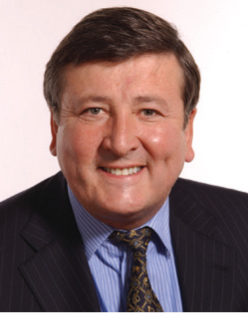Article

In 1984, Charles Handy, an Anglo-Irish philosopher, wrote a book entitled ‘The Empty Raincoat.’1 In this elegantly written book, he popularized the phrase ‘The McNamara Fallacy’ although it had been described some years earlier by Daniel Yankelovich (1924–2017).
In essence, a McNamara's fallacy means that it is wrong ‘to make important something which one can measure – rather than measuring the important things’. Anytime something unimportant is measured, and is then claimed to be a valid surrogate for measuring something that really is important, but when that arbitrary measurement does not do that accurately, it is an example of McNamara's fallacy.
Unfortunately, McNamara's fallacies abound in dentistry. The wider context is that over the last 20 years, dentistry, as well as medicine, have both become corrupted by this malign ‘measurement at all costs’ approach. The perverse result of this fetish for measuring something/anything that can be measured easily means that some important, but difficult-to-measure, things in dentistry get ignored.
Since 2006, instead of measuring the seriously important things, such as the long-term outcomes for patient's health and their dentition, or ensuring that patients received compassionate, effective, dental advice and/or treatment, NHS dentistry in England and Wales fell victim to a McNamara's fallacy when it became measured in facile, and corrupting, ‘Units of Dental Activity’ (UDAs).
In 2019, Professor Seamus Mahony, an Irish gastroenterologist who spent much of his working life as a consultant in the English NHS, published a fascinating, but deeply troubling, book called Can Medicine be Cured? The Corruption of a Profession.2 In it, there is a great chapter on the McNamara's fallacy, which Professor O'Mahony described as follows:
‘In essence, the McNamara Fallacy consists of various steps:
The origin of the term ‘McNamara's fallacy’
A McNamara's fallacy is named after Robert McNamara (1916–2009). He was the US Secretary of State during the presidencies of John F Kennedy (often referred to as ‘JFK’), and also of Lyndon Baines Johnson (often abbreviated to ‘LBJ’).
McNamara graduated from Berkeley and, having taken an MBA at Harvard, he became the youngest professor there at the age of 24. He specialized in statistical methodology. During World War II he served in the US military's Department of Statistical Control and used his flair with statistics to achieve a remarkable improvement in the efficiency of aerial bombing. He worked with General Curtis LeMay on the firebombing of Japanese cities, when approximately 100,000 civilians died in a single night. After World War II finished, McNamara went to work for the Ford Motor Company, which was in deep financial trouble at that time. He used his skills with statistics to help to return it to profitability, and he became the president of the Ford corporation at the age of 44 in 1960.
However, just a few months later, he accepted USA President John F Kennedy's offer to become the US Secretary of State for Defence, just as the Vietnam War was really taking off. Once again, he used his quantitative approach to count the deaths of the combatants on both sides in that war. His strong belief was that, so long as the Viet Cong casualties exceeded those of the dead Americans, which McNamara insisted should be counted systematically, that the war would be won, eventually, by the USA. Gradually, that ‘body count’ metric came to be used as the preferred way for US generals to rank the effectiveness of different American combat units and to dish out promotions accordingly. Perhaps unsurprisingly, counting the dead Viet Cong bodies then became ‘gamed’ by some in the American army. For instance, it was a lot easier, and somewhat safer, to count the already dead Viet Cong bodies than it was to take serious risks to kill any new people and therefore, the counting of existing corpses became a military objective in its own right. That arbitrary measurement then became a target, because there was an incentive to achieve it, and because it was being rewarded with promotions.3
Increasingly, many Americans became weary and more opposed to that foreign war, which involved many of their conscripted young men being killed for no perceived benefit to them. Anti-Vietnam war protestors outside the White House increasingly chanted ‘LBJ…LBJ…how many kids did you kill today?’
Over time, McNamara concluded, reluctantly, that the Vietnam war was unwinnable. He wrote to USA President Johnson (LBJ) suggesting the commencement of peace negotiations. Johnson then eased McNamara out of the administration. Subsequently, McNamara went on to be President of the World Bank from 1968 to 1981, which he led with considerable success. That was probably because many of the things involved, such as currencies, could be measured accurately and he was probably more comfortable with figures and spreadsheets than he was with the harsh realities of war.
The real lesson from McNamara's fallacy in Vietnam was that counting something, just because one can do so easily, can be dangerously misleading. That becomes an ever more serious risk if all the complexities involved, and the full context in which the measurements are intended to be used, are not fully understood. That becomes especially dangerous if someone makes an erroneous assumption that an arbitrary, but easy-to-record measurement can be used as a reliable surrogate for assessing something very important, but which is difficult to measure, but which would result in the desired outcome. Instead of measuring the relevant and really important things, something simpler and more convenient gets measured instead. Once available, that measurement is given unwarranted credibility and often then claimed to be the appropriate measurement when, in all truth, it is nothing of the sort.

OK. Interesting enough. But what is the relevance of the McNamara's fallacy measurement approach to today's problems in dentistry?
Dentistry, like medicine, has always been gloriously imprecise, uncertain and dependent on multiple complex and changing variables. Realistically, many of those important factors are difficult to measure reliably, and most are outside the absolute control of dental professionals. Some of those variable factors include the patient's frequency of contact with dietary sugars or various erosive acids, their habits, the effectiveness of their regular brushing with the appropriate strength of fluoride toothpaste, as well as the availability and the effective daily usage by that individual of long-handled tapering interdental and interspace brushes. Other important, but difficult to measure considerations include an individual patient's genetic susceptibility to various oral and/or systemic diseases, or their numbers of years of smoking, including that patient's (honest) daily consumption of tobacco, or other substances. Other unknown factors include people having available, and drinking, appropriately fluoridated water and/or their social circumstances, especially poverty.
Many of those risk issues are really important in the development of various oral problems, but they are largely outside the control of dental professionals. That inconvenient truth is something that some braying politicians, civil serpents (sic) and/or some questionably informed GDC regulators do not appear to appreciate enough. Dental professionals can give the relevant good advice, but they cannot force patients to comply with that advice.
Into that minestrone of immeasurables, one could add other difficult-to-quantify aspects including an individual patient's expectations, the real-life availability and practical affordability of professional dental care for them, not to mention the huge variability within the people receiving it, or delivering it.
One McNamara fallacy in dentistry is the sustained delusion that all this complexity can yield itself to simplistic numerical analysis. This leads to over-reliance on crude metrics, such as UDAs in dentistry, or on totally arbitrary, but easy-to-record figures, such as waiting times to be seen by someone in a hospital emergency department, or to be treated in secondary care hospitals. The facile assumption that this extremely complicated mix of healthcare issues can be reduced to a few crude metrics then leads to the setting of arbitrary targets by various ‘authorities’. Monitoring those targets requires expensive and time-consuming data collection and reporting, with each side employing a small army of administrators. Gaming of the system is commonplace because ‘what is measured gets done.’
Charles Goodhart, a UK economist, is well known for ‘Goodhart's law,’ which states that ‘when a measure becomes a target it ceases to be a good measure.’4 Sadly, but predictably, that is what happened with UDAs.
Some ‘immeasurables’ in dentistry
There are plenty of important things in dentistry that one cannot measure easily, or demonstrate convincingly to a bureaucratic organization, or to some semi-disinterested third party. Unquantifiable aspects of dentistry include compassion, consistency, clinical judgement, ethical behaviour, manual gentleness of touch, not to mention psychological, sculpting or artistic skills. Many patients can ‘feel’ and appreciate some of those important, if difficult-to-measure, aspects of dentistry, and most of them would expect that they would be given at least equivalent prominence in the provision of their dentistry. Sadly, in the present UDA system, and in some other systems, they are not.
Some of those immeasurable aspects might well be given lip service, but many dentists, especially before COVID-19 intervened so catastrophically, were forced by the NHS UDA system to pursue the questionably beneficial-for-patients UDA targets. If they did not achieve those, they were punished financially. Consequently, hitting the designated number of UDAs, and avoiding financial penalties, gradually became the main targets and, therefore, ceased to be a good measure of more important things – such as a patient's long-term dental health (Goodhart's law’ again).
The fallacy that the UDA system produces good dental health outcomes
One fallacy is that one UDA (average value £28) is an adequate reward for taking comprehensive patient histories, documenting them, examining patients thoroughly, doing special tests, making diagnoses, establishing trust and communicating effectively with any patient. The government-chosen measurement system allows for minimal time for all of this to be done properly. The multiply flawed NHS UDA measurement system adversely influences what gets done clinically, and often does not particularly help some deserving patients. For instance, the insulting three UDAs on offer for a difficult molar root filling has frequently resulted in the extraction of molar teeth that could have had a reasonable attempt at a root filling, and then be restored pragmatically with a well-sealing coronal restoration.5,6,7 The crazy UDA system has often invoked Merton's ‘Law of unintended consequences’.8 That law states that something that is done intentionally can produce an adverse outcome that was not intended. In the case of the measurement by UDAs, one (possibly unintended) result was to produce multiple extractions, or referrals to hospitals for routine endodontic, periodontal, prosthodontic or tooth surface loss/wear problems. Most of those referred problems could be addressed in NHS general dental practice, if there happened to be a fairer and more sensible system in place for doing so than the current UDA system.9
Some fallacies about ‘measuring and monitoring’ approaches to managing tooth surface loss problems
One important fallacy is that caries and tooth surface loss are very similar problems and, therefore, should be managed mainly by ‘advice and monitoring’.
Caries is a subsurface phenomenon that involves a slow net loss of calcium and phosphate ions, but there is still the matrix of the teeth left to be remineralized. In marked contrast, chemical erosion causes the surface, and the matrix of the teeth, as well as their calcium and phosphate ions, to disappear and, therefore, there is no matrix left to remineralize. Attrition and/or abrasion result in the physical and irretrievable loss of the matrix of the hard tissues. This means that the now-missing matrix cannot be remineralized, no matter how much ‘alginate manure’ is applied on the surface of the worn teeth, at arbitrary intervals, to make sequential, but dubiously accurate, plaster casts. Often, there is some combination of chemical and physical factors involved in tooth surface loss. However, interested and experienced clinicians can usually work out very quickly which is the predominant cause of that patient's particular problem.10
In Part 2 of this treatise, I will use the problems surrounding tooth surface loss to demonstrate the points made in Part 1 and discuss a wide variety of other fallacies that have crept into dentistry.

